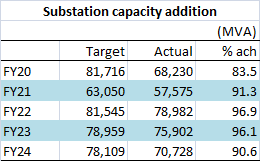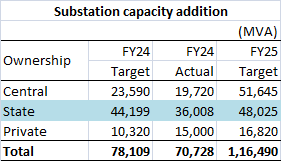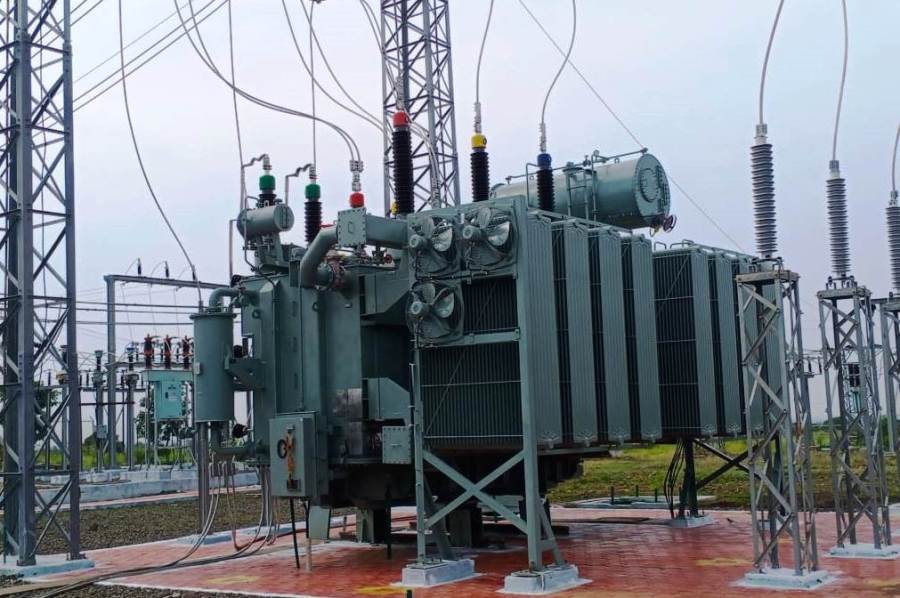India is likely to witness record transformation capacity addition in FY25, going by official statistics.
Latest reports by Central Electricity Authority (CEA) suggest that in the current fiscal year FY25 (April 1, 2024 to March 31, 2025), as much as 1,16,490 MVA of substation capacity is likely to come on stream.
 If this materializes, this would by far be the highest substation capacity added in any year, since the past five years at least. In fact, it would be only fair to assume that this would be the highest transformation capacity commissioned in any financial year, even historically.
If this materializes, this would by far be the highest substation capacity added in any year, since the past five years at least. In fact, it would be only fair to assume that this would be the highest transformation capacity commissioned in any financial year, even historically.
In recent history, the country saw its highest capacity addition in FY22 when 78,982 MVA came on stream. In FY23 too, the performance was encouraging with 75,902 MVA of new transformation capacity getting commissioned.
During FY20 and FY21 – two pandemic-affected years – substation capacity augmentation had been relatively poor, at 68,230 MVA and 57,575 MVA, respectively.
Over the past five years, from FY20 to FY24, the average transformation capacity addition has been around 70,300 MVA.
What is also heartening to note is that, over the recent past at least, there has not been significant shortfall in achieving the planned addition. On average, around 92 per cent of the planned addition has been achieved, considering the five-year period FY20 to FY24 (see table).
Going by this yardstick, even if 75 per cent of the planned addition in FY25 is realized, the actual addition would be around 87,300 MVA. This would still be highest transformation capacity added in any year so far.
Analysis of FY25
Of the 1,16,490 MVA of transformation capacity expected to commission in FY25, the biggest contribution — 51,645 MVA or 45 per cent of the total — will come from the Central public sector. State government transmission utilities will contribute 48,025 MVA (or 41 per cent), followed by the private sector that are likely to commission the remaining 14 per cent, or 16,820 MVA.
 Power Grid Corporation of India Ltd (PGCIL) is likely to commission as much as 50,700 MVA in FY25, which can be easily regarded as its best performance in recent years. In FY24, for instance, the entire Central government ownership group, which includes PGCIL and minority contributor Damodar Valley Corporation (DVC), had added just 19,720 MVA of substation capacity. In fact, PGCIL was responsible for the entire 19,720 MVA added in FY24. DVC had planned to commission 945 MVA in FY24 but recorded nil achievement.
Power Grid Corporation of India Ltd (PGCIL) is likely to commission as much as 50,700 MVA in FY25, which can be easily regarded as its best performance in recent years. In FY24, for instance, the entire Central government ownership group, which includes PGCIL and minority contributor Damodar Valley Corporation (DVC), had added just 19,720 MVA of substation capacity. In fact, PGCIL was responsible for the entire 19,720 MVA added in FY24. DVC had planned to commission 945 MVA in FY24 but recorded nil achievement.
Much of PGCIL’s envisaged substation capacity addition of 50,700 MVA is seen coming from its long shelf of around 24 under-construction ISTS-TBCB projects, including nine that were awarded in FY24. Besides, PGCIL has newly won five more ISTS projects under the TBCB route, in FY25 so far. This, of course, is in addition to its long list of projects awarded under the regulated tariff mechanism (RTM) mode.
Within the state government sector, the highest substation capacity addition is seen coming from Tamil Nadu (7,755 MVA), followed by Andhra Pradesh (6,850 MVA). Significant contributions are also seen coming from Madhya Pradesh, Uttar Pradesh, Gujarat and Haryana.
The projected private sector substation capacity addition of 16,820 MVA in FY25 will be led by Adani Energy Solutions Ltd (AESL) and Megha Engineering & Infrastructures Ltd (MEIL). Both these entities will be commissioning 6,000 MVA each, arising from their interstate and intrastate transmission projects. While Renew Transmission Ventures is scheduled to commission 2,500 MVA, Sterlite Power’s envisaged contribution would be 2,320 MVA. In both these cases, the new substations are associated with their respective interstate transmission system (ISTS) projects.
It may be mentioned that in FY24, the private sector did exceedingly well when it added 15,000 MVA substation capacity as against the planned 10,320 MVA, with AESL making a massive contribution of 10,000 MVA.
Cumulative status
As of April 30, 2024, India had total transformation capacity of 12,53,040 MVA coming from substations of 220kV or higher. Of this, roughly 23 per cent was from 765kV substations. The 400kV and the 220kV class accounted for around 37 per cent each. The remaining 3 per cent was from HVDC substations (converter stations) spread over different voltage classes – ±320kV, ±500kV and ±800kV.
Note: This story takes into account substations of 220kV or higher only.
Featured photograph (source: MPPTCL) is for representation only.



